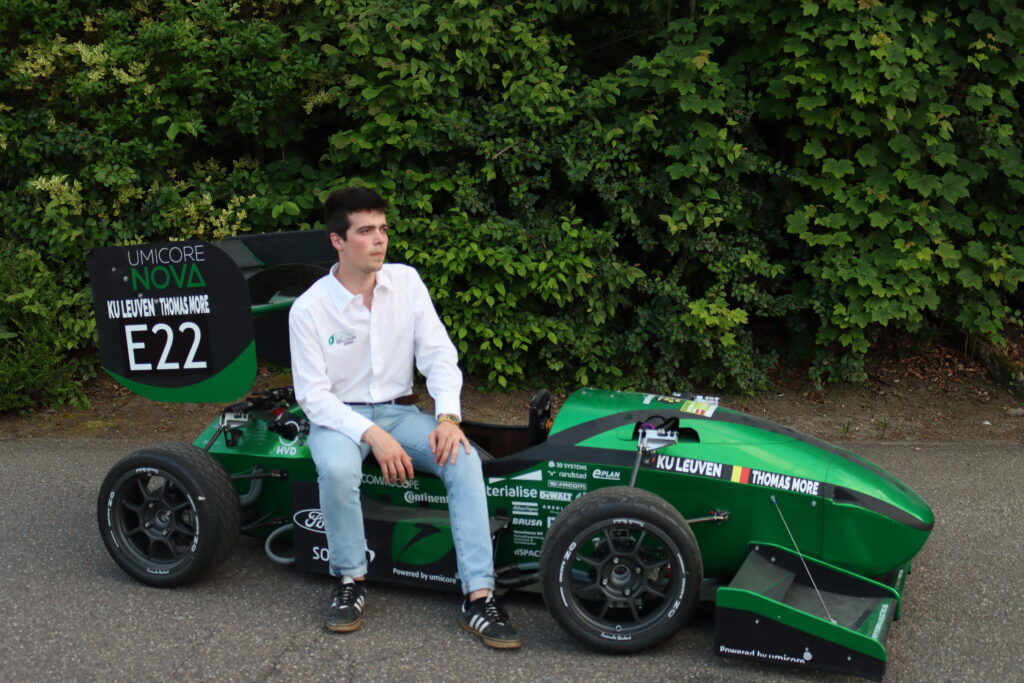Watch our rendered movie
Formula Student
What is Formula Student?
Formula Student is a platform for the next generation of world class engineers. It is Europe’s most prestigious engineering competition for students and it is organized by SAE International. The competition was organized in Europe for the first time in 1998 because there was a big demand for young engineers with practical experience in terms of teamwork, design and project planning. Nowadays teams all over the world participate in the competition.

Concept
Formula Student challenges university teams worldwide to design and build their own car in only nine months time. The performance of the car and the qualities of the team are being evaluated during static and dynamic events. To complete this mission successfully the team has to work together and think of creative solutions for the problems presented by the judges. An additional difficulty is completing the whole project within a certain budget and time. The competition involves combustion cars as well as electric cars. Formula Electric Belgium only participates in the electric class.
How does a competition work?
A Formula Student event is not only a race against the clock where the first one to cross the finish line is the winner. During several days the teams are subjected to different disciplines. A team can set its goal for a sublime result for one of the disciplines or go for the best all-round result. The events are divided into two categories: static and dynamic events. All participating teams can join in the static events. To compete in the dynamics, the teams have to qualify by passing very strict safety checks called ‘scrutineering’. If a team passed all checks it can participate in the dynamic events.
Events
Formula Student Electric
Formula Student Driverless
| DYNAMIC EVENTS | STATIC EVENTS |
| Acceleration | Cost Analysis |
| Skid Pad | Engineering Design |
| Autocross | Business Plan Presentation |
| Endurance | |
| Efficiency |
| DYNAMIC EVENTS | STATIC EVENTS |
| Acceleration | Engineering Design |
| Skid Pad | |
| Autocross | |
| Trackdrive |
Static Events
Cost Analysis
Cost management is very important for every product. In this event, the teams must write a cost report including the calculative size of the vehicle, its components and the necessary manufacturing steps.
The jury will then ask questions about this report which will be defended by the students.


Engineering Design
Teams must hand in an eight-page technical description of their car at the start of the Engineering Design competition. Teams competing with in the Driverless Cup must hand in an additional five-page description about the autonomous system. The documents must contain both design and how the design will be applied to the chosen construction. The jury will then evaluate these documents.
After the evaluation, the teams will be questioned by the judges with the focus on clarifying technical details, why they chose certain designs and testing their technical understanding.
Business Plan Presentation
Each team will present a business plan for a constructed prototype to a fictitious company represented by judges. The teams must demonstrate why their design meets the demands of their target group and illustrate how their design can me marketed.
The presentation is followed by a discussion with the judges where the presentation layout as well as the performance of delivering it will be evaluated.

Dynamic Events
Acceleration
The cars are placed in front of a 75 metre straight in which their acceleration from a standing start is measured. Traction and a good engine design are especially important in this event. The fastest cars of the competition can cross the line in less than 4 seconds reaching speeds of over 100 km/h!
Each team has 2 attempts (1 driver) in this event.


Skid Pad
In the Skid Pad event, cars must drive an 8 formed circuit performing 2 laps of each circle. In each case, the second lap is measured. The lap time of both circles gives a good indication of the maximum possible lateral acceleration the car can handle. Hitting a cone will result in an added time penalty.
Each team has 2 attempts (1 driver) in this event.
Autocross
For autocross, a 1 km long (electric) or 500m long (driverless) track needs to be completed as fast as possible without going off track or hitting a cone. A fast lap time is a sign of good dynamics, handling and acceleration as the track isn’t just a straight but consists of multiple, sometimes very sharp, turns. The result of this event decides the starting positions for the endurance event.
Each team has 4 attempts (2 per driver) in this event.


Endurance/Trackdrive
Endurance (Electric)
Over a distance of 22 km the cars have to prove their reliability. Every aspect of the car will be tested in this event!
Each team has only 1 attempt in this event with a driver change taking place after 11 km.
Trackdrive (Driverless)
Over a distance of 10 laps the cars have to prove the reliability of not only the car, but the algorithms as well. The car must complete the 10 laps in one stint and cones will not be replaced after it’s been hit.
Each team has only 1 attempt in this event.
Efficiency
During the endurance race energy consumption is precisely recorded. The consumption relative to speed is measured to calculate the score. This to prevent teams from driving very slowly in the endurance competition to score better on this discipline.

